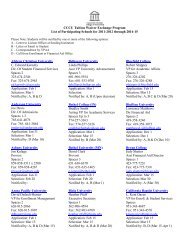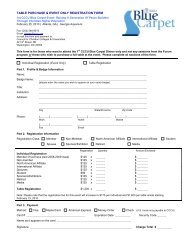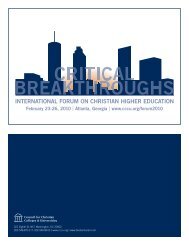Psychoanalysis, Attachment, and Spirituality Part II ... - Dr. Todd Hall
Psychoanalysis, Attachment, and Spirituality Part II ... - Dr. Todd Hall
Psychoanalysis, Attachment, and Spirituality Part II ... - Dr. Todd Hall
Create successful ePaper yourself
Turn your PDF publications into a flip-book with our unique Google optimized e-Paper software.
TODD W. HALL 31<br />
with mother, during which time most infants explore<br />
their environment while keeping an eye on their<br />
mother, <strong>and</strong> there is limited variability in infants’<br />
behavior. However, variability increases dramatically<br />
as the procedure continues. Next, mother leaves the<br />
room, then returns, then a stranger enters with mother<br />
in the room, <strong>and</strong> mother then leaves the infant<br />
with the stranger alone. The entrance of a stranger<br />
with mother still in the room reduces exploring<br />
behavior in almost all infants. However, when the<br />
mother leaves her infant with the stranger, the behavior<br />
of over half the children changes abruptly, <strong>and</strong><br />
clear differences in the organization of attachment<br />
emerge (Bowlby, 1982). The strange situation procedure<br />
provides the opportunity to observe how an<br />
infant uses her caregiver for comfort <strong>and</strong> as a base for<br />
exploration, <strong>and</strong> the balance between attachment<br />
<strong>and</strong> exploration behaviors as the situation unfolds.<br />
A number of early studies used the criteria of<br />
strength of attachment to describe patterns of attachment<br />
(Schaffer & Emerson, 1964). Strength of attachment<br />
refers to whether, <strong>and</strong> to what degree, an infant<br />
protests when mother leaves for a brief period. This<br />
approach emphasizes the amount of a behavior but<br />
does not seek to underst<strong>and</strong> the underlying meaning<br />
of the behavior. As Ainsworth gained more experience<br />
observing infants with their mothers, she came<br />
to conclude that this quantitative approach to evaluating<br />
attachment patterns was not only insufficient,<br />
but could actually be misleading (Bowlby, 1982). For<br />
example, anxious-resistant infants exhibit strong<br />
protest when their mothers leave—more than secure<br />
infants—which could appear to be a sign of a more<br />
healthy attachment from a quantitative perspective.<br />
However, these infants are not able to derive comfort<br />
from their mothers, <strong>and</strong> are severely disabled in their<br />
ability to explore their environment.<br />
The combination of these behaviors reveals an<br />
underlying insecurity in the infant’s attachment.<br />
Thus, within this broader context, Ainsworth postulated<br />
that the security of an infant’s attachment is<br />
the most important dimension in evaluating it.<br />
Ainsworth’s focus on the evaluation of the meaning<br />
of various attachment behaviors was a pivotal first<br />
step in moving attachment theory closer to a theory<br />
of relational meaning, <strong>and</strong> hence closer to the relational<br />
psychoanalytic trajectory that was developing<br />
independently during this same time period. This<br />
was further developed by Sroufe <strong>and</strong> Waters (1977)<br />
in a key article emphasizing attachment as an organizational<br />
construct. In this article, Sroufe <strong>and</strong> his colleagues<br />
likewise emphasized the subjective meaning<br />
of attachment behavior rather than simply the frequency<br />
of certain behaviors.<br />
The convergence within the attachment tradition<br />
came to a head in the mid-1980s, when attachment<br />
theorists shifted from a focus on infant behavior to a<br />
focus on the subjective experiences <strong>and</strong> dynamic<br />
internal representations in the infant <strong>and</strong> parent,<br />
largely as a result of the development of the Adult<br />
<strong>Attachment</strong> Interview (Main, Kaplan & Cassidy,<br />
1985). Mary Main, Nancy Kaplan, <strong>and</strong> Jude Cassidy<br />
(1985) reported evidence that the way adults discussed<br />
their past relationships with their own parents<br />
was reliably associated with the attachment classifications<br />
of their own infants in the Strange<br />
Situation. For example, adults who idealized their<br />
own parents but could not provide clear memories<br />
in support of such appraisals (classified as dismissing<br />
adults), generally had children who behaved in an<br />
avoidant manner in the Strange Situation. Adults<br />
who strayed from the AAI questions, or who exhibited<br />
intense anger toward their parents (i.e., preoccupied<br />
adults) typically had children who were classified<br />
as anxious-resistant in the Strange Situation. In<br />
contrast, secure adults who produced coherent <strong>and</strong><br />
believable narratives about their relationships with<br />
their parents tended to have children who were<br />
secure in the Strange Situation.<br />
What they came to see was that the underlying<br />
meaning of early relational experiences are represented<br />
<strong>and</strong> become manifest in the way adults tell<br />
their attachment-related stories. They eventually codified<br />
these narrative styles in the coding system for<br />
the Adult <strong>Attachment</strong> Interview (see Hesse, 1999).<br />
Research in the Adult <strong>Attachment</strong> Interview tradition<br />
has burgeoned in recent years, <strong>and</strong> has contributed<br />
to the growing interest in narrative<br />
approaches to human experience, to which we will<br />
return shortly. In addition, AAI research has paved<br />
the way for exploring the implications of attachment<br />
theory for clinical work.<br />
In this vein, several authors have noted a growing<br />
sense of “paradigm boundedness” within attachment<br />
theory, <strong>and</strong> the need for theoretical paradigms that<br />
enrich clinical work, <strong>and</strong> clinically relevant research<br />
<strong>and</strong> theory (e.g., Fonagy, 2001; Mitchell, 2000). As a<br />
result, a number of attachment researchers, <strong>and</strong> clinicians<br />
influenced by attachment theory, are now integrating<br />
their findings with contemporary psychoanalysis<br />
<strong>and</strong> articulating their clinical implications.<br />
One area of attachment research that has led to rich


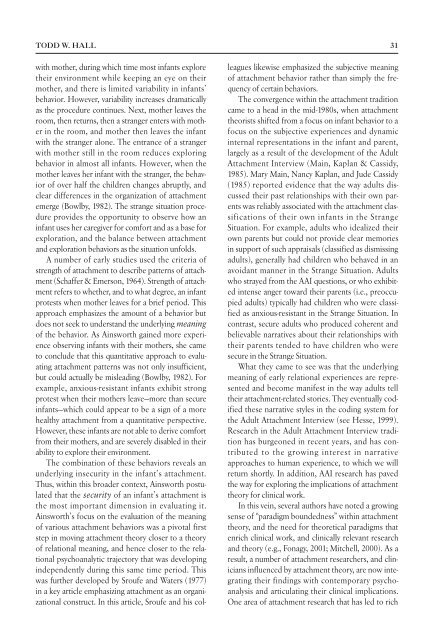

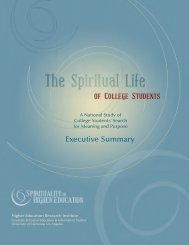
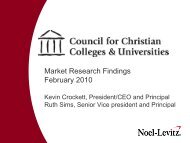


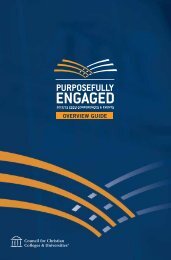


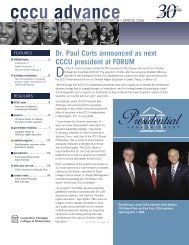
![Download Guide [PDF] - Council for Christian Colleges & Universities](https://img.yumpu.com/37211849/1/190x245/download-guide-pdf-council-for-christian-colleges-universities.jpg?quality=85)
